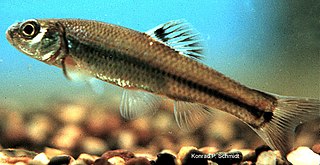
The flathead catfish, also called by several common names including mudcat or shovelhead cat, is a large species of North American freshwater catfish in the family Ictaluridae. It is the only species of the genus Pylodictis. Ranging from the lower Great Lakes region to northern Mexico, it has been widely introduced and is an invasive species in some areas. The closest living relative of the flathead catfish is the much smaller widemouth blindcat, Satan eurystomus.

The pumpkinseed, also referred to as pond perch, common sunfish, punkie, sunfish, sunny, and kivver, is a small/medium-sized North American freshwater fish of the genus Lepomis, from family Centrarchidae in the order Perciformes.

The Ictaluridae, sometimes called ictalurids, are a family of catfish native to North America, where they are an important food source and sometimes fished for sport. The family includes about 51 species, some commonly known as bullheads, madtoms, channel catfish, and blue catfish.

The brown bullhead is a fish of the family Ictaluridae that is widely distributed in North America. It is a species of bullhead catfish and is similar to the black bullhead and yellow bullhead. It was originally described as Pimelodus nebulosus by Charles Alexandre Lesueur in 1819, and is also referred to as Ictalurus nebulosus.

The channel catfish is North America's most numerous catfish species. It is the official fish of Kansas, Missouri, Nebraska, and Tennessee, and is informally referred to as a "channel cat". In the United States, they are the most fished catfish species with around 8 million anglers targeting them per year. They also have very few teeth and swallow food whole. The popularity of channel catfish for food has contributed to the rapid expansion of aquaculture of this species in the United States. It has also been widely introduced in Europe, Asia and South America, and it is legally considered an invasive species in many countries.

The black bullhead or black bullhead catfish is a species of bullhead catfish. Like other bullhead catfish, it has the ability to thrive in waters that are low in oxygen, brackish, turbid and/or very warm. It also has barbels located near its mouth, a broad head, spiny fins, and no scales. It can be identified from other bullheads as the barbels are black, and it has a tan crescent around the tail. Its caudal fin is truncated. Like virtually all catfish, it is nocturnal, preferring to feed at night, although young feed during the day. It generally does not get as large as the channel or blue catfish, with average adult weights are in the 1-to-2-pound range, and almost never as large as 4 pounds (1.8 kg). It has a typical length of 6–14 inches (15–36 cm), with the largest specimen being 24 inches (61 cm), making it the largest of the bullheads. It is typically black or dark brown on the dorsal side of its body and yellow or white on the ventral side.

Ameiurus is a genus of catfishes in the family Ictaluridae. It contains the three common types of bullhead catfish found in waters of the United States, the black bullhead, the brown bullhead, and the yellow bullhead, as well as other species, such as the white catfish, which are not typically called "bullheads".

The bayad, is a species of bagrid catfish from Africa.

Ictalurus pricei, the Yaqui catfish, is a species of North American freshwater catfish native to Mexico and Arizona.

Synodontis petricola, known as the cuckoo catfish, or the pygmy leopard catfish, is a species of upside-down catfish endemic to Burundi, Zambia, the Democratic Republic of the Congo, and Tanzania where it is only known from Lake Tanganyika. It was first described by Belgian ichthyologist Hubert Matthes in 1959. The species name "petricola" is derived from a combination of the Latin petra, meaning stone or rock, and the Latin cola, meaning inhabitant. This refers to the rocky environment where this species is found.

The white bullhead, also known as the white catfish, is a member of the family Ictaluridae of the order Siluriformes.
Noturus flavus, the stonecat, is a North American freshwater catfish of the family Ictaluridae. The common name is due to its habit of hiding near or under stones in fast-moving water.

The bullhead minnow is a species of freshwater demersal fish, native to the southern United States.

Ameiurus platycephalus, the flat bullhead, is a species of North American freshwater catfish native to the waters of the southeastern United States from Virginia to Georgia. This species grows to a maximum length of 29 cm (11 in) TL though it is more commonly about 23 cm (9 in) long.

The snail bullhead is a bony fish in the family Ictaluridae distributed widely in the southeastern United States. Among its bullhead catfish congeners, it has many North American relatives, like the brown bullhead and black bullhead. The species was described in 1877 by David Starr Jordan in the Ocmulgee River in Georgia.















